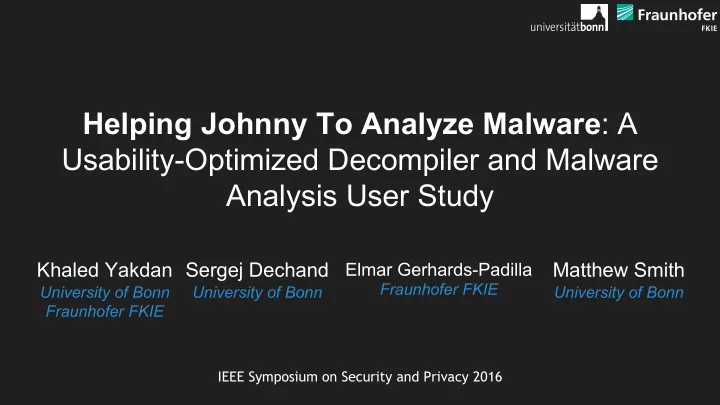

Helping Johnny To Analyze Malware : A Usability-Optimized Decompiler and Malware Analysis User Study Khaled Yakdan Sergej Dechand Matthew Smith Elmar Gerhards-Padilla Fraunhofer FKIE University of Bonn University of Bonn University of Bonn Fraunhofer FKIE IEEE Symposium on Security and Privacy 2016
Which code would you rather analyze? 080483f9 <bar>: 80483f9: push %ebp 80483fa: mov %esp,%ebp 80483fc: sub $0x10,%esp 80483ff: movl $0x0,-0x4(%ebp) int bar(int a1){ 8048406: movl $0x1,-0x8(%ebp) int v1 = 0; 804840d: cmpl $0x0,0x8(%ebp) int v2 = 1; int bar(int max){ 8048411: jle 8048435 <bar+0x3c> if(a1 > 0){ int result = 1; 8048413: pushl -0x4(%ebp) do{ 8048416: call 80483cb <foo> for(int i = 0 ; i < max ; i++){ 804841b: add $0x4,%esp v2 = v2 * foo(v1); result = result * foo(i); 804841e: mov %eax,%edx v1 = v1 + 1; } 8048420: mov -0x8(%ebp),%eax } while(v1 < a1); return result; 8048423: imul %edx,%eax } } 8048426: mov %eax,-0x8(%ebp) return v2; 8048429: addl $0x1,-0x4(%ebp) 804842d: mov -0x4(%ebp),%eax } 8048430: cmp 0x8(%ebp),%eax 8048433: jl 8048413 <bar+0x1a> 8048435: mov -0x8(%ebp),%eax 8048438: leave 8048439: ret
Decompilation v2 = 0; if(v1 != 0){ i = 0; do{ while(i < size){ foo(v2); foo(i); v2 = v2 + 1; i = i + 1; } while(v2 < v1); } } Source Code Decompiled Code High-level Recovered 1010010101 abstractions abstractions 0010101010 are lost 1001010101 0000100100 0011100101 Binary Code
Previous Work on Decompilation • Do not focus on readability • Do not include user studies in the evaluation • Readability metrics: • Compression ratio (smaller is better?) • Number of gotos (less is better?)
Our Work on Decompilation v2 = 0; if(v1 != 0){ 1010010101 do{ 0010101010 for(i = 0; i < size, i++){ foo(v1); 1001010101 foo(i); v2 = v2 + 1; } 0000100100 } while(v2 < v1); 0011100101 } DREAM This work: (NDSS’15) ➊ Usability extensions to DREAM ➋ Malware analysis user study
Usability Extensions to DREAM
Solved Readability Problems Convoluted Control Flow Complex Expressions ● Duplicate/Inlined Code ● Redundant variables ● Complex loop structure ● Logic expressions ● Pointer arithmetic Lack of Semantics ● Unrepresentative variable names ● Named constants
Hex-Rays: Domain generation algorithm (Simda) if ( v13 > 0 ) void *__cdecl sub_10006390(){ { __int32 v13; // eax@14 v16 = 1 - &v23; int v14; // esi@15 for ( i = 1 - &v23; ; v16 = i ) unsigned int v15; // ecx@15 { int v16; // edx@16 v17 = &v23 + v14; Many char *v17; // edi@18 v19 = (&v23 + v14 + v16) & 0x80000001; bool v18; // zf@18 Variables v18 = v19 == 0; Complex logic unsigned int v19; // edx@18 if ( (v19 & 0x80000000) != 0 ) char v20; // dl@21 Pointer Expressions v18 = ((v19 - 1) | 0xFFFFFFFE) == -1; char v23; // [sp+0h] [bp-338h]@1 v20 = v18 ? *(&v37 + dwSeed / v15 % 6) Arithmetic int v30; // [sp+30Ch] [bp-2Ch]@1 : *(&v30 + dwSeed / v15 % 0x14); __int32 v36; // [sp+324h] [bp-14h]@14 ++v14; int v37; // [sp+328h] [bp-10h]@1 v15 += 2; int i; // [sp+330h] [bp-8h]@1 *v17 = v20; // [...] if ( v14 >= v36 ) v30 = *"qwrtpsdfghjklzxcvbnm"; break; v37 = *"eyuioa"; } // [...] } v14 = 0; // [...] v15 = 3; }
DREAM++: Domain generation algorithm (Simda) LPVOID sub_10006390(){ char * v1 = "qwrtpsdfghjklzxcvbnm"; char * v2 = "eyuioa"; // [...] int v13 = 3; for(int i = 0; i < num; i++){ char v14 = i % 2 == 0 ? v1[(dwSeed / v13) % 20] : v2[(dwSeed / v13) % 6]; v13 += 2; v3[i] = v14; } // [...] }
Malware Analysis User Study
User Study • Tested Decompilers • DREAM++ (readability improvements) • DREAM • Hex-Rays • 6 malware reverse engineering tasks • Counterbalanced decompiler order • Counterbalanced task order • User perception after each task • Feedback at the end of the study
Task Selection • Independent professional malware analysts • 6 Tasks • Encryption (Stuxnet) • Custom Encoding (Stuxnet) • Resolving API Dynamically (Cridex) • String Parsing (URLZone) • Download and execute (Andromeda) • Domain generation algorithms (Simda)
Participants Two groups 1.Students • 36 invited • 21 completed the study 2.Professional malware analysts • 31 invited • 17 started the study • 9 completed the study
Results Average Score (%) Decompiler Students Experts DREAM++ 70.24 84.72 DREAM 50.83 79.17 Hex-Rays 37.86 61.39
Results Students • Solved 3 times as many tasks with DREAM++ as with Hex-Rays Professional malware analysts • Solved 1.5 times as many tasks with DREAM++ as with Hex-Rays
User Perception • 8 Questions • 6 Usability • 2 Trust • Questions are counterbalanced (positive/negative) to minimize the response bias
User Perception “The code mostly looks like a straightforward C translation of machine code; besides a general sense about what is going on, I think I'd rather just see the assembly.” - DREAM “This code looks like it was written by a human, even if many of the variable names are quite generic. But just the named index variable makes the code much easier to read! ” – DREAM++
Final Feedback • Show code produced by all decompilers side by side • Scores from 1(worst) to 10 (best)
Summary and Future Work • Readability improvements to DREAM • First malware analysis user study • Human-centric approach can significantly improve the effectiveness of decompilers • Focus on other use cases • Vulnerability search in binary code
Recommend
More recommend